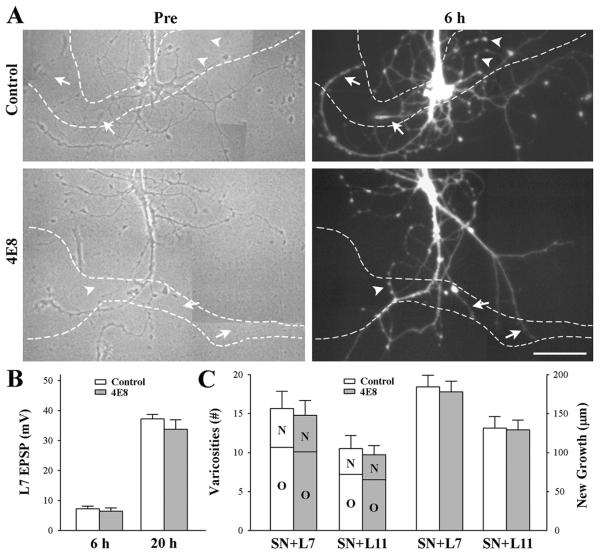Figure 4.
Reducing ApCAM from the surface of the sensory neurons does not affect synapse formation and growth. Sensory neurons were plated and treated overnight with either control or anti-ApCAM antibody 4E8, washed, and then axon growth was imaged prior to plating L7 or L11 (only SN + L7 cultures are shown here). After 6 h, EPSPs were recorded and in some cultures sensory neurons were injected with carboxyfluoroscein to map out new growth by the sensory neurons. Other cultures were maintained overnight and EPSP amplitudes were re-examined. A. Phase contrast images (left) of axon growth from sensory neurons treated overnight with control IgG or 4E8. The dashed outline represents the position of the motor neuron L7 (axon hillock and original axon) that was plated with each sensory neuron after taking the images. Treatment with 4E8 does not impact on axon growth by sensory neuron. On the right are epifluorescent images of neuritic growth following injection with carboxyfluorescein from the same sensory neurons after 6 h of interacting with the motor neurons. Arrowheads point to some of the varicosities and arrows point to some of the new branches that had grown over the 6 h of interaction. The white dash lines represent the borders of the L7 motor neurons. Treatment with 4E8 failed to block new growth and formation of new varicosities. The bar equals 75 μm. B. Reducing ApCAM from the surface of the sensory neurons did not interfere with synapse formation. The height of each bar is the MEAN ± SEM of the EPSP amplitudes recorded at 6 h and 20 h. ANOVA indicated no significant effect of treatment with 4E8. At 20 h both control- and 4E8-treated cultures had formed strong synapses. C. Reducing ApCAM from the surface of the sensory neurons did not interfere with growth and formation of new varicosities. The height of each bar is the MEAN ± SEM of the total number of varicosities contacting L7 or L11 (left bars) and the length of new sensory neuron axon branches contacting L7 or L11 (right bars). For each treatment and culture (n = 6 for each treatment of SN + L7 or SN + L11 cultures), sensory neuron varicosities contacting each target were divided into two groups: old varicosities (O) on pre-existing sensory neuron axon branches when the motor neuron was first plated and new varicosities (N) formed by new axon growth. Irrespective of target (L7 or L11), treatment with 4E8 had no impact on growth. Growth and varicosity number were higher for sensory neurons contacting L7 then sensory neurons contacting L11.

